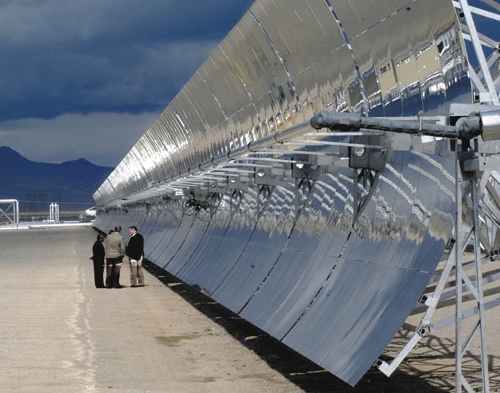Report: Las Vegas’ green economy still green

At least it pays well.
That’s one of the few high points in a new report that gives middling marks to Southern Nevada’s green economy.
The Brookings Institution’s Metropolitan Policy Program today releases rankings placing Las Vegas in the bottom half of the nation’s 100 biggest cities in the size, concentration and export power of its green economy, a sector that includes renewable energy, mass transit, recycling and energy-saving building materials.
"In some areas, especially in green building and in solar photovoltaics, Las Vegas has genuine strengths," said Mark Muro, a senior fellow and policy director with Brookings. "But on that big basket of broader measures, it’s true that the region doesn’t look fantastic. It’s clearly not a major player at this point."
Las Vegas had just under 10,000 clean jobs in 2010, ranking it No. 54 among the country’s biggest metro areas. That jobs count made up 1.2 percent of the local employment base, a concentration that ranked No. 84 nationwide. Las Vegas came in at No. 87 on exports, creating international exports worth $5,937 per green job in 2009.
Cities with more green jobs than Las Vegas included Albuquerque, N.M.; Columbus, Ohio; Buffalo, N.Y.; and Providence, R.I.
The local green economy fared better in its growth rate, adding 3,125 jobs from 2003 to 2010, for an average of 5.6 percent annual growth. Only 21 cities expanded their green economies faster in the same period.
Las Vegas also ranked No. 8 for green wages. The city’s median annual green-job salary in 2009 was $46,590, compared with a median of $43,133 for all 100 cities analyzed. The city’s share of clean jobs offering good pay for modest education was 57.6 percent, compared with 67.7 percent nationwide.
Overall, though, the results look like a bit of a blow to the idea, often repeated by local and state officials and business leaders, that the green economy, from renewable energy to clean-product manufacturing, could turn around the Las Vegas economy.
Senate Majority Leader Harry Reid, D-Nev., has used his position to spotlight Southern Nevada’s green potential, drawing political luminaries such as Bill Clinton and Al Gore to his annual National Clean Energy Summit. Congress has allotted more than $1 billion in stimulus funds and loan guarantees to Nevada for renewable power lines, generating stations, home-weatherization programs and worker-training initiatives during the recession. And the Nevada Development Authority has included renewable energy on its list of economic-diversification targets for at least half a decade.
The Brookings report did register an especially big spike in local green-jobs creation after 2008, when federal stimulus spending jumped. Still, the study disappointed some local members of the green economy.
Steve Mevius, president of Henderson window-shade manufacturer Polar Shades Sun Control, said local and state officials haven’t done enough to attract green businesses.
"For the life of me, I can’t understand why we don’t have wind farms and more solar energy," Mevius said. "To think that Buffalo, where it snows and rains and everything else, has surpassed us. We have the highest unemployment rate in the nation. Think of the kinds of jobs that could be created."
Zac Petkanas, a spokesman for Reid, said the senator will continue to focus on building Southern Nevada’s green economy.
"Sen. Reid has made it one of his top priorities to ensure Nevada becomes the clean-energy jobs capital of the nation, which is reflected in the significant growth the state has experienced in the clean-energy sector since 2007 — greater than the country at large," Petkanas said in a statement. "However, there is much more to be done, and Sen. Reid is committed to building on his track record of attracting new renewable-energy companies to the state, making a brand new clean-energy transmission line spanning Nevada possible and creating thousands of good-paying clean-energy jobs that can’t be shipped overseas."
Las Vegas has been successful in growing some sub-sectors of its green market, Muro said.
The city has nearly four times the job concentration in solar photovoltaics as other cities have, on average.
Las Vegas also has more than seven times the typical concentration of jobs in green architecture and building, and is one of the strongest green-building markets in America. CityCenter, the world’s largest project certified through the U.S. Green Building Council’s Leadership in Energy and Environmental Design (LEED) program, played a key role in developing that concentration, Muro said. He added that Las Vegas also has many other LEED-certified buildings.
Local leaders should emphasize those strengths to boost the city’s green economy, Muro said.
"You can’t immediately become something you have never been, which is a major manufacturer and goods export center, but you could very much become a world player in solar photovoltaics and in green architecture and construction," he said.
That latter industry is where Mevius comes in, and he said he is indeed seeing big growth in demand for his sunshades. He’s recently shipped out orders for several major hotel chains on the East Coast. His business is on track to jump 80 percent this year. He has 40 employees now, but could double that in the next five years as businesses and homeowners alike look for energy efficiencies.
"We feel that the sky is the limit for us," Mevius said.
Contact reporter Jennifer Robison at jrobison@reviewjournal.com or 702-380-4512.